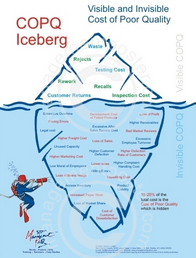 When seeking to measure and compare the performance of employees, many public service provides often focus on efficiency measure. To illustrate, take a moment or two to ponder this hypothetical scenario: Given the same resources (time, tools, training, etc), one of the workers in your team (let’s call him Bob), on average, repairs 10 potholes in a day whilst his colleague Billy repairs only 7 similar-sized potholes in the same period. Given a choice between the two workers, who would you retain? promote? give a pat on the back? Did you say Bob? That’s understandable – after all, he appears to be about 30% more productive than Billy. However what if I were to ‘fill you in’ with some more detail: Of the 10 potholes Bob repairs each day, on average 3 potholes have to be reworked, whilst all of Billy’s were right first time. Ah, now you are likely to take a different view of Bob’s performance. That scenario illustrates that we need to factor the ‘quality view’ into performance evaluation. Poor quality has a cost, some of it tangible e.g. cost of rework – time, material, opportunity cost; others intangible e.g. reputational cost, etc. And if you reckon the example above is far-fetched, check out this example where, over a six-month period, over 40% of the output from a public service subcontractor lacked the required level of detail. Over 40% !!
When seeking to measure and compare the performance of employees, many public service provides often focus on efficiency measure. To illustrate, take a moment or two to ponder this hypothetical scenario: Given the same resources (time, tools, training, etc), one of the workers in your team (let’s call him Bob), on average, repairs 10 potholes in a day whilst his colleague Billy repairs only 7 similar-sized potholes in the same period. Given a choice between the two workers, who would you retain? promote? give a pat on the back? Did you say Bob? That’s understandable – after all, he appears to be about 30% more productive than Billy. However what if I were to ‘fill you in’ with some more detail: Of the 10 potholes Bob repairs each day, on average 3 potholes have to be reworked, whilst all of Billy’s were right first time. Ah, now you are likely to take a different view of Bob’s performance. That scenario illustrates that we need to factor the ‘quality view’ into performance evaluation. Poor quality has a cost, some of it tangible e.g. cost of rework – time, material, opportunity cost; others intangible e.g. reputational cost, etc. And if you reckon the example above is far-fetched, check out this example where, over a six-month period, over 40% of the output from a public service subcontractor lacked the required level of detail. Over 40% !!
So, do you factor quality into your performance evaluation? Are you aware of your organization’s Cost of Poor Quality (CoPQ)? How do you work out this cost? What do you do with this information?
Please share….


